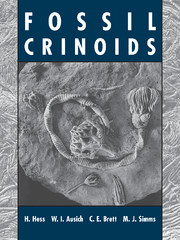Book contents
- Frontmatter
- Contents
- List of Contributors
- Acknowledgements
- Prelude
- Introduction
- GENERAL PART
- ASSEMBLAGES
- 6 Middle Ordovician Trenton Group of New York, USA
- 7 Middle Ordovician of the Lake Simcoe Area of Ontario, Canada
- 8 Upper Ordovician of the Cincinnati, Ohio, Area, USA
- 9 Silurian of Gotland, Sweden
- 10 Middle Silurian Rochester Shale of Western New York, USA, and Southern Ontario, Canada
- 11 Scyphocrinitids from the Silurian–Devonian Boundary of Morocco
- 12 Lower Devonian Manlius/Coeymans Formation of Central New York, USA
- 13 Lower Devonian Hunsrück Slate of Germany
- 14 Middle Devonian Windom Shale of Vincent, New York, USA
- 15 Middle Devonian Arkona Shale of Ontario, Canada, and Silica Shale of Ohio, USA
- 16 Lower Mississippian Hampton Formation at LeGrand, Iowa, USA
- 17 Lower Mississippian Burlington Limestone along the Mississippi River Valley in Iowa, Illinois, and Missouri, USA
- 18 Lower Mississippian Edwardsville Formation at Crawfordsville, Indiana, USA
- 19 Upper Pennsylvanian LaSalle Member, Bond Formation of Central Illinois, USA
- 20 Permian
- 21 Triassic Muschelkalk of Central Europe
- 22 Pentacrinites from the Lower Jurassic of the Dorset Coast of Southern England
- 23 Lower Jurassic Posidonia Shale of Southern Germany
- 24 Middle Jurassic of Southern England
- 25 Middle Jurassic of Northern Switzerland
- 26 Upper Jurassic Solnhofen Plattenkalk of Bavaria, Germany
- 27 Uintacrinus Beds of the Upper Cretaceous Niobrara Formation, Kansas, USA
- 28 Tertiary
- 29 Recent
- Appendix I Geological Time Table with Crinoid Assemblages
- Appendix II Glossary of Rocks
- Bibliography
- General Index
- Taxonomic Index
23 - Lower Jurassic Posidonia Shale of Southern Germany
Published online by Cambridge University Press: 10 November 2010
- Frontmatter
- Contents
- List of Contributors
- Acknowledgements
- Prelude
- Introduction
- GENERAL PART
- ASSEMBLAGES
- 6 Middle Ordovician Trenton Group of New York, USA
- 7 Middle Ordovician of the Lake Simcoe Area of Ontario, Canada
- 8 Upper Ordovician of the Cincinnati, Ohio, Area, USA
- 9 Silurian of Gotland, Sweden
- 10 Middle Silurian Rochester Shale of Western New York, USA, and Southern Ontario, Canada
- 11 Scyphocrinitids from the Silurian–Devonian Boundary of Morocco
- 12 Lower Devonian Manlius/Coeymans Formation of Central New York, USA
- 13 Lower Devonian Hunsrück Slate of Germany
- 14 Middle Devonian Windom Shale of Vincent, New York, USA
- 15 Middle Devonian Arkona Shale of Ontario, Canada, and Silica Shale of Ohio, USA
- 16 Lower Mississippian Hampton Formation at LeGrand, Iowa, USA
- 17 Lower Mississippian Burlington Limestone along the Mississippi River Valley in Iowa, Illinois, and Missouri, USA
- 18 Lower Mississippian Edwardsville Formation at Crawfordsville, Indiana, USA
- 19 Upper Pennsylvanian LaSalle Member, Bond Formation of Central Illinois, USA
- 20 Permian
- 21 Triassic Muschelkalk of Central Europe
- 22 Pentacrinites from the Lower Jurassic of the Dorset Coast of Southern England
- 23 Lower Jurassic Posidonia Shale of Southern Germany
- 24 Middle Jurassic of Southern England
- 25 Middle Jurassic of Northern Switzerland
- 26 Upper Jurassic Solnhofen Plattenkalk of Bavaria, Germany
- 27 Uintacrinus Beds of the Upper Cretaceous Niobrara Formation, Kansas, USA
- 28 Tertiary
- 29 Recent
- Appendix I Geological Time Table with Crinoid Assemblages
- Appendix II Glossary of Rocks
- Bibliography
- General Index
- Taxonomic Index
Summary
ICHTHYOSAURS AND THE LARGEST SEA LILIES EVER FOUND
The Swabian Posidonienschiefer is named after the occurrence of the bivalves Bositra buchi and the very abundant Steinmannia radiata, both species being formerly assigned to Posidonia. The Posidonienschiefer have furnished to museums all over the world some of the most spectacular fossils, including ichthyosaurs, fishes, rare plesiosaurs, crocodiles, flying reptiles (pterosaurs) and the magnificent crinoid Seirocrinus subangularis. This sea lily, with its beautiful flower-like crowns and stems reaching more than 20 m in length, has been known for a long time. As early as 1742 Hiemer, a clergyman who wrote in Latin, described a slab from Ohmden with several individuals as Caput Medusae (head of medusa), comparing it to the ophiuroid with branched arms already known at that time. Hiemer was convinced that the animals were transported by the Flood from the Black Sea to the Stuttgart area, and this created considerable excitement at the time.
The Posidonienschiefer, which occur at the foot of the Swabian and Franconian Alb between the rivers Rhine and Main, belong to the Lower Jurassic (Lower Toarcian, Lias Epsilon, 185 million years before present) and are part of a facies widely distributed in Europe at that time (Fig. 192). They were laid down during three ammonite zones (tenuicostatum, but especially during the falciferum and bifrons Zones) (Fig. 193); a duration of about 0.5 million years has been estimated for the entire period of black shale deposition (Littke et al. 1991). The fossils from the communities of Holzmaden, Ohmden, Bad Boll and Dotternhausen, east and south of Stuttgart, are the best known. A few quarries are still in use and furnish highly priced fossils.
- Type
- Chapter
- Information
- Fossil Crinoids , pp. 183 - 196Publisher: Cambridge University PressPrint publication year: 1999
- 13
- Cited by

